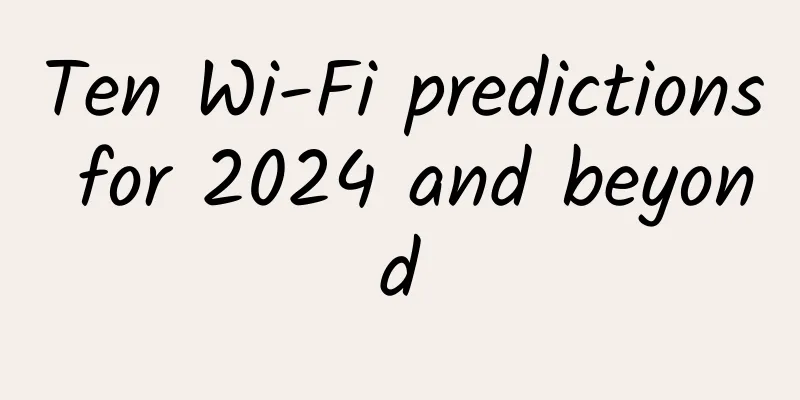Ten Wi-Fi predictions for 2024 and beyond

|
As available spectrum increases around the world, there has never been an more exciting time for Wi-Fi. Following the release of the WBA 2024 Annual Industry Report, here are the top 10 Wi-Fi predictions for 2024 and beyond. We believe they will transform the way communities and businesses around the world use wireless technology, including improved connectivity, efficiency, and new consumer experiences. 10 Gbps speeds will become commonplace – Fiber broadband deployments will continue to expand in most developed and developing markets, requiring upgrades to home Wi-Fi networks to deliver the increased bandwidth to devices, which will drive rapid adoption of Wi-Fi 6E and Wi-Fi 7. The ability to operate on additional spectrum will also drive adoption as more countries open up the 6 GHz band. Wi-Fi 7 capabilities will drive immersive experiences and advance gaming and video content. A recent report from Bain & Company predicts that global video game revenue will grow another 50% over the next five years. In a sport where milliseconds matter, networking equipment is just as important to gaming as the speed of your gaming rigs. With Wi-Fi 7 being essential for speed and near-zero latency, game developers will break new barriers with immersive experiences. Wi-Fi 7 client devices have been released in 2023 using Qualcomm chipsets, with more products coming in 2024. Convergence will continue to evolve, enabling access to private and public 5G services over Wi-Fi. Network managers are expected to continue deploying Wi-Fi and cellular networks over the next few years, with Wi-Fi 6E/7 for indoor, campus, and fixed network environments and 5G cellular for outdoor, off-campus, and mobile environments. Rather than competing with 5G on emerging high-performance use cases, the Wi-Fi community continues to work on coexistence with 5G, especially in identity management, authentication, and policy management. Network as a Service (NaaS) will spread rapidly beyond early adopters, such as managed Wi-Fi in multi-apartment units, to traditional enterprises where the network provides a cloud-first, software-defined, application-centric environment. NaaS appeals to customers because it accelerates and simplifies device deployment in today’s shortened equipment replacements and improves security by providing continuous security updates to prevent and mitigate breaches and outages. The role of artificial intelligence and machine learning cannot be overstated, and adaptive AI will explode across the network, from enabling automatic frequency coordination (AFC) to predicting network resource needs. AI will help enterprises and ISPs speed up troubleshooting; simplify monitoring; and proactively predict outages, equipment failures, and performance degradation. Outdoor AFC will initially be successful in rural connections in countries that have opened up large portions of the 6GHz spectrum to Wi-Fi. 6GHz low-power indoor (LP) devices with an average transmit power of 24 dBm are expected to quickly gain popularity in indoor applications such as residential mesh networks, indoor public spaces, and high-density enterprise networks. 6GHz very low-power indoor (VPI) devices with a maximum transmit power of 14 dBm are also expected to be quickly adopted by short-range indoor applications such as AR/VR/XR, streaming, and gaming. These device categories do not require automatic frequency coordination (AFC) coordination with existing devices. New IoT technologies will help unify the connectivity of multiple home devices and change the experience of home users using IoT devices. Matter is a new industry standard launched in 2023 that provides reliable and secure connectivity for multiple device manufacturers. Given the importance of relevant players such as Apple, Amazon, Google and Samsung SmartThings, the adoption of Matter certified products is expected to grow exponentially over the next three years, thus verifying the core role of Wi-Fi in smart connected homes and buildings. TIP Open Wi-Fi pilots and trials will proliferate in developing countries and price-sensitive markets due to its cost-effectiveness and the benefits of an open classification model. Established wireless LAN (WLAN) vendors will continue to work to make themselves more cost-effective in these markets through significant investments in machine learning and artificial intelligence and by providing integrated Wi-Fi + 5G products for enterprises. Augmented reality and virtual reality will take a larger share of our daily lives at home and work, but they will require indoor broadband networks to adapt to improvements in user interfaces and network capabilities to meet the needs of a larger user base. According to Bloomberg, the Metaverse economy is expected to generate $800 billion by 2025 and $2.5 trillion by 2030. Therefore, the Metaverse is the universe of the future. Major brands are investing heavily in this technology. |
>>: Guidelines for Protecting RS-232 Serial Connections
Recommend
QQ account stolen in 22 years, friends help verify but appeal is invalid: the confusion behind Tencent's authentication system
Recently, user Mr. Wang revealed to a reporter fr...
Working principles of physical layer/data link layer/network layer
[[279942]] Physical Layer Physical layer equipmen...
New IT Navigation: SDN shifts from technology-driven to application-driven
The energy of digital technologies represented by...
Cybersecurity risks of smart devices
Many people don’t consider the risks that smart d...
Is 4G still better? China Mobile suddenly admitted: 50 million 5G users do not use 5G network
At the 2021 Mobile World Congress, Liu Liehong, V...
The first comprehensive definition, the "2022 Enterprise Application Operation and Maintenance Management Index System White Paper" was officially released
Recently, Borei Data and iResearch jointly releas...
Essential HTTP knowledge for front-end developers! Just read this article! !
HTTP Origin HTTP was initiated by Tim Berners-Lee...
What are the most exciting IoT trends for 2018?
The Internet of Things is accelerating its entry ...
Let's talk about three kinds of custom networks in Docker (bridge, macvlan, overlay)
Docker provides a variety of network drivers, all...
China Mobile and Radio and Television Announce Four Major Agreement Details on 5G Co-construction and Sharing
On January 26, China Mobile and China Broadcastin...
How does 5G open the door to huge technological advancement for manufacturing companies?
The rollout of 5G is expected to usher in the Fou...
ZJI: Hong Kong Kwai Wan signature CN2 server bandwidth free upgrade to 20Mbps, special models monthly payment starts from 450 yuan
This month, ZJI has upgraded the bandwidth of CN2...
Can 5G drive innovation in the smart home market?
[[348075]] We still have a long way to go before ...
China's fourth largest telecommunications operator is here
Chinese people are already familiar with the thre...
Hosteons: OpenVZ/KVM VPS hosting 50% off, $13.5 per year, multiple data centers in Los Angeles/New York
The last time I shared information about Hosteons...









